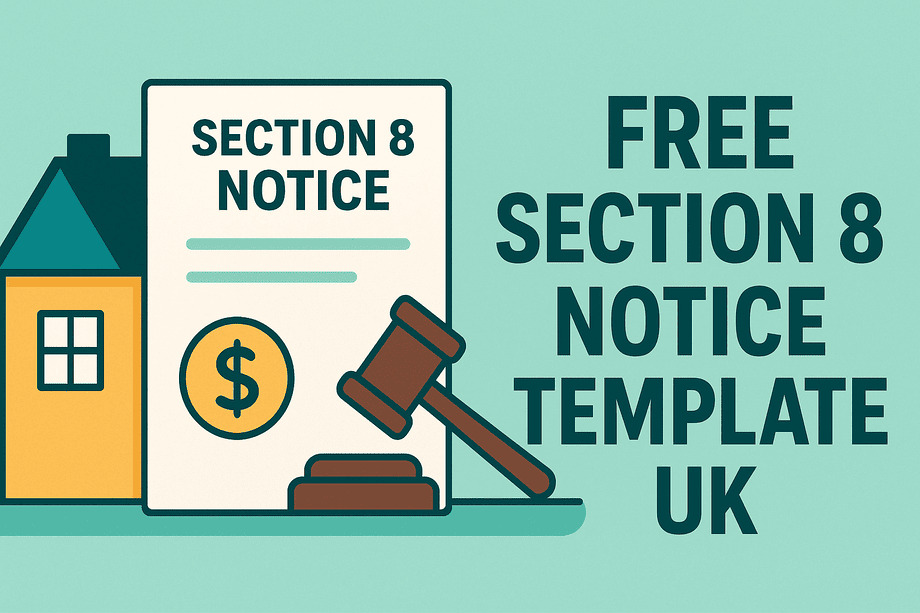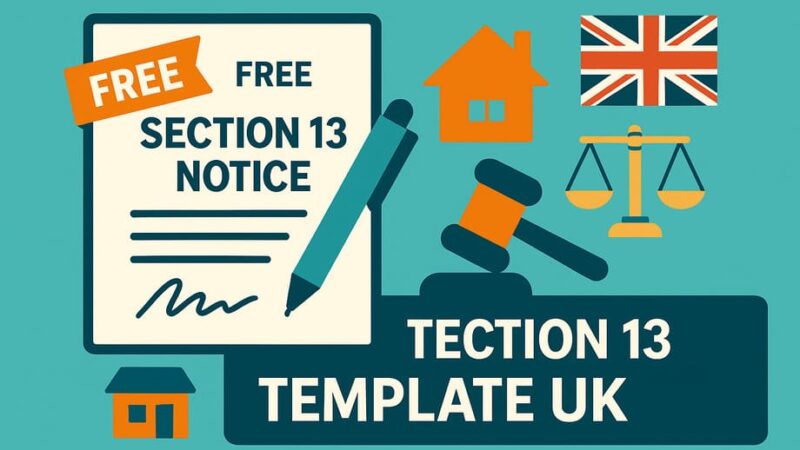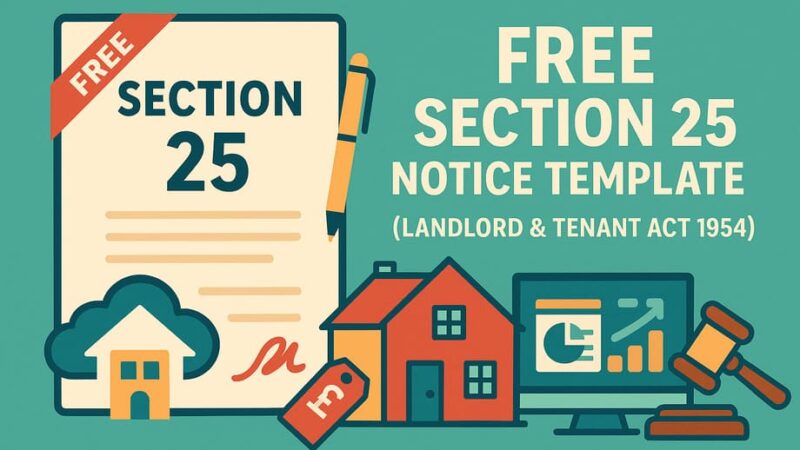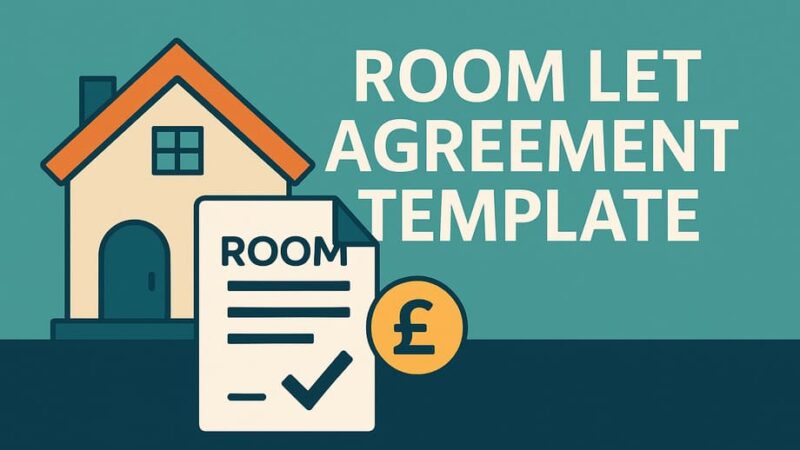Free Section 8 Notice Template UK

When tenants breach their tenancy agreement or fail to pay rent, landlords need a Section 8 notice to start legal eviction proceedings. Unlike Section 21 no-fault evictions, Section 8 requires proving specific grounds for possession but can be served during fixed-term tenancies and may result in faster court proceedings.
This guide provides a free Section 8 notice template (Form 3) plus everything you need to know about grounds for possession, serving procedures, and avoiding common mistakes that could invalidate your notice.
What is a Section 8 Notice?
A Section 8 notice is a legal document that starts the process of evicting tenants who have breached their tenancy agreement. It’s called a “fault-based eviction” because you must prove the tenant has done something wrong.
Key differences from Section 21:
- Section 8: Requires proving tenant fault (rent arrears, damage, etc.)
- Section 21: No reason needed (“no-fault eviction”)
When to use Section 8:
- Tenant has rent arrears
- Property damage beyond normal wear and tear
- Breach of tenancy agreement terms
- Antisocial behavior or nuisance
- During fixed-term tenancies (if agreement permits)
For use in England only – Wales, Scotland and Northern Ireland have different procedures.
Section 8 Grounds for Possession
There are 17 grounds you can use for Section 8 eviction, divided into two categories:
Mandatory Grounds (1-8)
If proven, the court must grant possession. Most commonly used:
Ground 8 – Serious Rent Arrears
- Weekly rent: 8+ weeks in arrears
- Monthly rent: 2+ months in arrears
- Quarterly rent: 3+ months in arrears
- Must be in arrears both when serving notice AND at court hearing
Discretionary Grounds (9-17)
The court decides if eviction is reasonable. Most commonly used:
Ground 10 – Some Rent Arrears
- Any amount of rent unpaid when notice served
- Still unpaid at court hearing
Ground 11 – Persistent Late Payment
- Regular pattern of late rent payments
- Even if no arrears at hearing
Ground 12 – Breach of Tenancy Agreement
- Unauthorized pets, subletting, commercial use
- Any violation of specific tenancy terms
Ground 13 – Property Damage
- Damage beyond normal wear and tear
- Includes damage by tenant’s visitors
Ground 14 – Antisocial Behavior
- Nuisance to neighbors
- Criminal activity on premises
- Domestic violence
Pro tip: You can use multiple grounds in one notice to strengthen your case.
Free Section 8 Notice Template – Form 3
Here’s your free, legally compliant Section 8 template:
DOWNLOAD: Section 8 Notice (Form 3)
NOTICE SEEKING POSSESSION OF A PROPERTY LET ON AN ASSURED TENANCY
OR AN ASSURED AGRICULTURAL OCCUPANCY
FORM NO. 3
Housing Act 1988 section 8 (as amended)
INFORMATION FOR TENANTS
This notice tells you that your landlord intends to begin proceedings for possession
of the property identified below. You should read it carefully and seek advice about
your circumstances as quickly as possible.
Free independent advice is available from:
• Shelter: 0808 800 4444 or shelter.org.uk
• Citizens Advice
• Housing advice centres
• Law centres
If you believe you are at risk of homelessness, contact your local authority.
1. TO: ___________________________________________________
[Full name(s) of ALL tenants - exactly as on tenancy agreement]
2. YOUR LANDLORD intends to apply to the court for an order requiring you to
give up possession of:
___________________________________________________
[Complete property address including postcode]
3. YOUR LANDLORD intends to seek possession on ground(s):
☐ Ground 8 ☐ Ground 10 ☐ Ground 11 ☐ Ground 12
☐ Ground 13 ☐ Ground 14 ☐ Other: _______
in Schedule 2 to the Housing Act 1988, which read(s):
[Insert full text of each ground from Schedule 2]
Ground 8: "Both at the date of the service of the notice seeking possession
and at the date of the hearing, at least eight weeks' rent is unpaid if the
rent is payable weekly or fortnightly and at least two months' rent is
unpaid if the rent is payable monthly..."
[Continue with full text for each ground selected]
4. PARTICULARS - Give full explanation of why each ground applies:
Ground 8 particulars:
- Rent amount: £_______ per _______
- Current arrears: £_______
- Period covered: From _______ to _______
- Arrears calculation: [Show detailed breakdown]
[For other grounds, provide specific details with dates, evidence,
and reference to tenancy agreement clauses]
5. The court proceedings will not begin earlier than: _______________
[Date must allow proper notice period - minimum 2 weeks for most grounds]
6. If your landlord does not apply to court within 12 months from service
of this notice, this notice will lapse.
7. NAME AND ADDRESS OF LANDLORD/AGENT:
Name: ________________________________________________
Address: _____________________________________________
_____________________________________________
_____________________________________________
Telephone: __________________________________________
LANDLORD'S SIGNATURE SECTION
Signed: _______________________________________________
Name: ________________________________________________
Address: _____________________________________________
Capacity (tick one):
☐ Landlord
☐ Joint Landlord
☐ Landlord's Agent
Date: ________________________________________________
NOTES FOR TENANTS:
• You have the right to remain until a court makes a possession order
• A landlord who unlawfully evicts tenants commits a criminal offence
• You may be entitled to housing benefit or universal credit for rent
• Contact your local authority if you need housing advice
What Must Be Included in Your Section 8 Notice
Essential Requirements:
1. All Tenant Names
- List every tenant from the original tenancy agreement
- Use exact names as they appear on the agreement
- Include tenants who moved out – missing any name invalidates the notice
2. Complete Property Address
- Full address including postcode
- Must match tenancy agreement exactly
- Include flat/unit numbers if applicable
3. Correct Grounds
- Select appropriate grounds from Schedule 2
- Include full legal text of each ground
- Don’t abbreviate or summarize
4. Detailed Particulars
For rent arrears:
- Exact amount owed
- Calculation breakdown
- Period dates covered
- Payment history
For property damage:
- Specific damage description
- Photos and repair estimates
- Inventory comparisons
For tenancy breaches:
- Specific agreement clauses violated
- Dates and evidence of breaches
- Any warnings given
5. Proper Notice Period
- Ground 8, 10, 11, 13, 14: Minimum 2 weeks
- Other grounds: Check specific requirements
- Count from day after service
6. Landlord Details and Signature
- Complete name and address
- Contact telephone number
- Proper signature and date
- Specify capacity (landlord/agent)
How to Serve a Section 8 Notice
Acceptable Service Methods:
1. Personal Service (Best Evidence)
- Hand deliver directly to tenant
- Get written acknowledgment if possible
- Use witness if tenant refuses to sign
2. Postal Service
- Recorded delivery to property address
- Keep delivery receipt as proof
- Allow extra time for postal delays
3. Through Property Letterbox
- Post through letterbox at rental property
- Take timestamped photos as evidence
- Ensure secure delivery
4. Email (If Agreed)
- Only if tenancy agreement permits
- Get delivery receipt confirmation
- Follow up with hard copy
Service Evidence Requirements:
- Keep proof of when and how served
- Photographs of delivery
- Witness statements
- Postal receipts
- Any tenant acknowledgment
Notice Period Calculation:
- Starts day after service
- Minimum 2 weeks for most grounds
- Must expire on correct date
- Account for postal delays
Common Section 8 Mistakes to Avoid
Form Errors
- Using wrong form or old version
- Missing tenant names
- Incorrect property address
- Wrong grounds selected
- Insufficient particulars/evidence
Service Problems
- No proof of service
- Incorrect service method
- Wrong notice period calculation
- Serving during “breathing space” debt relief
Evidence Issues
- Inadequate rent arrears records
- Poor quality damage photos
- Missing witness statements
- Incomplete payment history
Legal Requirements
- Not using prescribed Form 3
- Missing full ground text
- Unsigned or undated notice
- Wrong landlord details
What Happens After Serving Section 8
If Tenant Doesn’t Leave
- Wait for notice period to expire
- Apply to court using Forms N5 and N119
- Pay court fee (currently £355)
- Attend court hearing
- Get possession order if successful
- Apply for bailiff enforcement if needed
Tenant’s Options
- Pay arrears (may stop Ground 8 if below threshold)
- Remedy breach (for discretionary grounds)
- Challenge notice in court
- Seek legal advice and housing support
- Apply for debt relief (“breathing space”)
Timeline Expectations
- Undefended mandatory grounds: 2-3 months
- Defended discretionary grounds: 6-12 months
- Complex cases: 12+ months
Section 8 vs Section 21: When to Use Each
Use Section 8 When:
- Tenant has breached agreement
- During fixed-term tenancy
- Need urgent possession
- Want to claim rent arrears
- Section 21 restrictions apply
Use Section 21 When:
- No specific tenant fault
- Fixed term has ended
- Want certainty of possession
- Avoid proving grounds
- Less court time/evidence needed
Important: Section 21 may be abolished in 2025, making Section 8 knowledge even more crucial.
Section 8 Notice FAQs
Can I use Section 8 during a fixed-term tenancy?
Yes, if your tenancy agreement includes a “forfeiture clause” or “break clause” that allows early termination for breach. Check your agreement carefully.
How much rent arrears do I need for Ground 8?
- Weekly rent: 8+ weeks
- Monthly rent: 2+ months
- Quarterly rent: 3+ months
Must be in arrears at both notice service and court hearing.
Can I claim damages with Section 8?
Yes, you can claim:
- Unpaid rent
- Property damage costs
- Court fees
- Legal costs (if court awards them)
What if tenant pays arrears before court?
- Ground 8: If they pay below threshold, you lose this ground
- Grounds 10/11: Court may still grant possession for payment history
- Multiple grounds: Other grounds may still apply
How long is Section 8 notice valid?
12 months from service date. Must start court proceedings within this time or serve new notice.
Can tenants challenge Section 8?
Yes, tenants can challenge:
- Technical errors in notice
- Insufficient evidence
- Wrong grounds used
- Improper service
- Proportionality (discretionary grounds)
Download Your Free Section 8 Template
Get your legally compliant Section 8 notice template:
- Form 3 compliant with current regulations
- All required sections and prescribed information
- Step-by-step completion guide
- Service instructions and best practices
- Common mistakes checklist
Available formats:
- PDF: Print and complete by hand
- Word: Editable for multiple properties
- Guidance notes: Complete instructions
[DOWNLOAD PDF] | [DOWNLOAD WORD] | [VIEW SAMPLE]
Legal Disclaimer
This free Section 8 template provides guidance only and is not legal advice. Section 8 procedures can be complex, and mistakes can be costly. Consider professional legal advice for:
- Complex tenancy situations
- High-value properties
- Vulnerable tenants
- Multiple ground scenarios
- Court representation
Always ensure compliance with current housing legislation and consider professional property management services for complex eviction cases.
Need to evict a problem tenant? Download our free Section 8 template and follow our step-by-step guide to serve a legally valid fault-based eviction notice in England.
Last Updated on August 25, 2025 by James Cartwright







![Letter to Tenant for Late Rent Payment [Free Template] 7 Letter to Tenant for Late Rent Payment [Free Template]](https://www.yourpropertyblog.co.uk/wp-content/uploads/2025/08/letter-to-tenant-for-late-rent-payment-template-800x450.jpg)